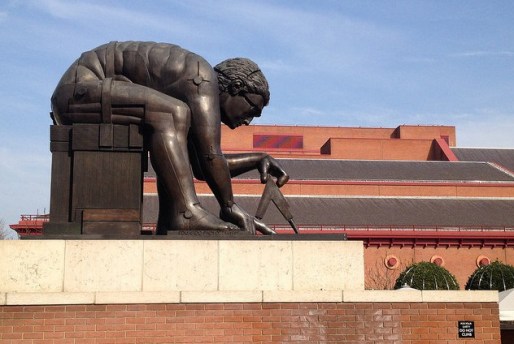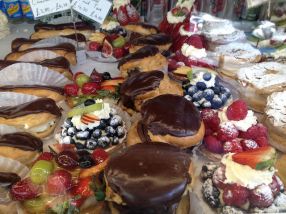I’m just back from a couple of crime-filled days in London. The main reason for my visit was to speak at a symposium on European crime fiction and data visualisation (of which more later), but I travelled up a day early in order to see the Forensics exhibition at The Wellcome Trust.
I’ve already written about the Forensics exhibition in a previous post, so here’s a summary of the parts I particularly liked.
- Its focus, as one would expect, is scientific, but it also incorporates photography and artwork reflecting on violence, murder and its aftermath, which provide some genuinely thought-provoking perspectives.
- Frances Glessner Lee’s ‘Nutshell Study of Unexplained Death’ – a crime scene recreated in a dollhouse for police training purposes in the 1940s – was fascinating for its miniature juxtaposition of detailed handcrafts and gruesome homicide.
- Room 4, which explores how forensic archaeologists have gathered evidence of political and war crimes in Chile, Rwanda and Yugoslavia, was highly moving in its emphasis on bearing witness and justice.
- The vast array of exhibits yielded wildly diverse treasures such as exquisite drawings of deadly plants, a porcelain Royal Doulton morgue table and Sir Bernhard Spilsbury’s hand-written autopsy cards (although I did wonder how the poor victims would have felt about having their personal details on public display…).
- I took some great new definitions and phrases away with me: the word ‘autopsy’ means ‘to see with one’s own eyes’ and constitutes ‘the last chance to question the dead’; Eduard Locard, head of the first police crime lab in Lyon, introduced ‘the exchange principle’, based on the theory that ‘every contact leaves a trace’ (perpetrator on victim and victim on perpetrator), and Erle Stanley Gardener asserted that medical experts giving evidence at trials ‘must serve but one client, and that client should be truth’.
A note of warning: the exhibition is not for faint-hearted, as some of the images and commentary it contains are extremely graphic. I was grateful for a strong and steadying cup of coffee in the Wellcome Cafe afterwards. But I would highly recommend a visit – see the exhibition website for more details here.
Friday was spent at the British Library, taking part in the symposium ‘Towards a Digital Atlas of European Crime Fiction?’ – part of an AHRC project run by Dominique Jeannerod and Federico Pagello of Queen’s University Belfast. The project is evidence of how rapidly the ‘digital humanities’ – which explore the contribution of ‘big data’, technology and data visualisation to humanities research – are expanding, and was of course particularly interesting as it considered these areas in relation to European crime.
The morning was spent hearing the project contributors’ findings. What I liked about this section was the chance to see some data visualisations, to discuss the metho-dological and technical challenges involved in their creation (e.g. getting from ‘dirty’ to ‘clean data’), and to get an idea of the kinds of case studies involved (French, Hungarian and European crime). I had expected the speakers to be evangelical about digital research, but they discussed its advantages and disadvantages in very even-handed and thoughtful ways – such as the capacity of ‘distant reading’ to make trends visible against the time that inputting and cleaning data can take. The project is designed to have an exploratory function and as someone considering increased use of digital methods in my research, I found these reflections very useful indeed.
The afternoon saw presentations from researchers on diverse digital tools and analysis in research on Czech, French, New Zealand and German crime (the latter from yours truly, on my Nazi-themed crime fiction database and this blog), as well as a talk from Samuel Schwiegelhofer of the Paris Bibliothèque des littératures policières (BiLiPo – a library dedicated to crime fiction!). That was followed by a marvellous keynote from Ian Sansom (crime author and academic), which ranged from the work of theorist Franco Moretti to the horse’s head in The Godfather and Ian’s garden shed.

Professor Ian Sansom with his shed. Photo by Federico Pagello
All in all, the symposium was a rich and valuable experience, not least because it provided the chance to meet like-minded researchers from around the world, and has made me think deeply about my own research and its digital possibilities. Many thanks to the organisers for making it such a successful event.
If you’re interested in finding out more about the project, then take a look at the International Crime Fiction Research Group blog or follow the group on Twitter – @crimefictionrg. A website with lots of useful resources is on its way.
Last but not least, the trip provided a great opportunity to meet friends and co-conspirators from the crime blogosphere, including Jacky Collins, Andy Lawrence, Ewa Sherman and Sarah Ward. There were pilgrimages to The Scandinavian Kitchen and Maison Bertaux (the latter, London’s oldest patisserie, was a great find courtesy of Andy).
Large amounts of cake may have been consumed.







Sounds like a very productive and enjoyable few days! Congratulations and will be checking out the links you mention.
It really was a great few days 🙂 Yes, do check out the blog – there’s lots of really interesting stuff posted there.
Sounds as though you had a terrific time, Mrs. P! I’m glad everything went well, too. Thanks for sharing so much useful and interesting information about the Wellcome exhibition. I would have very much liked to to see that, myself. Looking forward to the rest of your posts about data visualisation.
Thanks, Margot. I always find that giving and listening to presentations help to develop your research (sometimes in unexpected ways…). And yes, a really good exhibition. There’s some great stuff online about it, but it’s obviously never quite the same as seeing it yourself. Wish you could have been here!
Me, too…
Thanks for the vicarious trip, and I very much agree about the boost one can get from going to a well-organised conference, an intelligent museum or a delightful cafe!
You’re welcome! A lovely boost, especially when all three of the ingredients you mention are involved. Lucky to have the opportunity to do such wonderful things.
Next month I’ll be in White Mountains of New Hampshire, very close to “Mother” Lee’s summer home The Rocks. May have to do some investigating of my own!
Tell me more, David?!
My summer retreat is a friend’s 19th century Inn just up a hill or two from The Rocks. http://therocks.mobi/about.html “Mother” Lee was made an honorary Captain in the New Hampshire State Police in 1943, the first woman in the US to hold that rank. Might provide good post for Murder Is Everywhere blog site. Especially since my current WIP is set in my friend’s “haunted” inn.
Ooh, that all sounds very good! And what a lovely retreat to have.
I’m hooked. I can hardly tear myself away from cirme fiction to read my classics. What have you done to me? All kidding aside, it is a great thrill to discover great writing in this genre. This post with all the info an links will be just more inspiration to keep reading. Finished ‘Camille’ ( Sacrifices read in French) by Lemaitre and am searching for the next CF. Just a random question: which CF book pops into you head ‘ right now’ as a reading tip. I love a spontenous tip!
Happy to take all the credit for your conversion to crime, N@ncy 🙂
I must read Camille – I had hesitated because of what I’d heard about the hard-hitting first section, but everyone has urged me to read on after that point, so am going to take the plunge.
Which crime novel pops into my head right now? Hakan Nesser’s Borkman’s point – a longstanding favourite…
Yes…the scene during the hold-up in a jewelry store is graphic…but just keep reading.
Thanks for the suggestion….I will look it up!
Sounds like the trip was quite enjoyable, conference, museum and the patisserie. I’m sure the Nordic desserts are good, too.
I’ve been enjoying British and Swedish crime fiction television episodes. I am so hooked! And the Irene Huss series is quite good, as is Broadchurch season 2. They are cutting into the reading, but are quite enjoyable.
It was a good trip, Kathy – a lovely mixture of all sorts of different activities. London feels like a giant playground: there are so many great things to see and do.
It sounds like you’re in a very nice crime drama phase. I’ve not seen any of the Irene Huss (am making a note of that), but have recently started an American courtroom drama series – The Good Wife – which I’m enjoying very much. Nice to see some strong female protagonists (some of whom I remember watching on ER many moons ago).
there should always be cake
Absolutely.
The Good Wife is one of the best TV dramas on over here. Some friends consider it the best.
Cast and scripts are good and important issues are touched upon, too. Yes, strong women characters.
Nearly at the end of season 1 now, but lovely to know there are another 5 to come!